 |
 |
 |
| | Home | People behind the Scenes | Jakucho Setouchi | Yume no Ukihashi |
| |
|
|
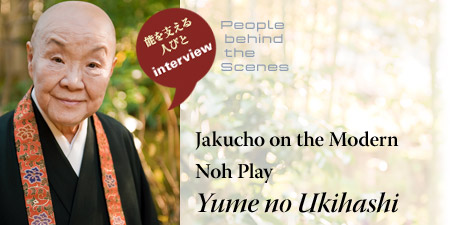
| Yume no Ukihashi | |
| Characters (principal cast) | Ajari (Rokurō Umewaka) Niōmiya (Hisanori Kongō) Ukifune (Shinya Umewaka) |
| First performance | March 3, 2000, Four Day Show |
| Venue | National Noh Theatre |
| Written by | Jakucho Setouchi |
| Directed by | Tōjirō Yamamoto, Rokurō (now Genshō) Umewaka |
In the 700 years of Noh history, Noh plays created from the Meiji era onward are known as modern Noh. One of these is Yume no Ukihashi, reated by Jakucho Setouchi on the request of the National Noh Theatre and first performed in 2000 (Heisei 12). This play, based on The Tale of Genji, was special in that it has been played several dozen times, where modern Noh plays are almost never performed more than once. (Reference: Noh Trivia: How Long are Modern Noh Plays “Modern?”)
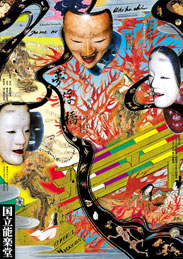 |
Poster designed by Tadanori Yokoo [click on photo to enlarge] |
![]()
There was a woman chanting Buddhist prayers along the Uji River in Kyoto. Passing by the river, Ajari asked her the reason. She said that the noblewoman she had served had thrown herself into the river, but her body was never found, so she prayed by the river instead of by her grave. Ajari gathered that this noblewoman was Ukifune, and told her that he had received news that the one who had saved Ukifune, his own master Sōzu Eshin, had died and that he was hurrying to his grave. Ukifune felt they had a mysterious connection, and followed Ajari to the grave in Yokawa near Mount Hiei.
Arriving at the grave of Sōzu Eshin, Ajari prayed for the forgiveness of his sins. Ajari had actually gone crazy over Ukifune’s beautiful black hair, had fled the temple in a fit of delusion, and was wandering from place to place living a troubled life.
Ajari then saw a vision of Ukifune and Niōnomiya in the midst of a passionate encounter in a small boat. Ukifune was actually in love with another man, Kaoru, and her suffering from her love for two men pushed her to throw herself in the Uji River. And while she was saved by Sōzu Eshin, Ukifune decided to leave home and be taken in by a Buddhist monk. At that time it was Ajari who cut her hair on the order of his master. Ajari was taken by a fiery, sensual passion by the wavy, almost alive hair, and took a handful of locks for himself. Ajari then became a delusional apostate priest suffering the pains of hell. And while Ajari suffered greatly, after that he placed a hair in the grave of his master and gained enlightenment through chants to Buddha.
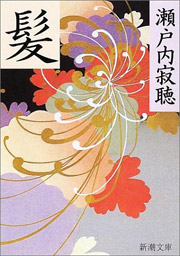 |
Kami Jakucho Setouchi Shinchō Bunko A collection of short stories including Kami inspired by Yume no Ukihashi in the Tale of Genji that later became modern Noh plays. |
The short novel Kami became a modern Noh play
Before writing this Noh play, I wrote the novel Kami (“Hair”). Based on the story of Ukifune that appears in Ujijūjō in The Tale of Genji, I imagined and wrote that the Sōzu Yokawa who helped Ukifune had an apprentice. Rokurō Umewaka (now Genshō Umewaka) also read Kami. I asked him if it was okay; he responded “yes, yes go ahead,” and it was decided.
Umewakwa often plays the role of a female shite, but in this play we had him play Ajari. Afterwards he ended up playing the role of Ukifune though because she was such a beautiful woman (laughingly). But I think Ajari is better. In the part where he was crazy, Rokurō gave a performance in which he ran and hugged the hashira. I was quite surprised.
The part Murasaki Shikibu was able to write only because she left home
In The Tale of Genji, the part about Ukifune leaving home is written very specifically. What the master did, how the hair was cut. And in the story many women appear but they only do simple things like leave home or cry. There is no part where the head is shaved. But the scene in Ujijūjō where Ukifune leaves home is extremely specific. I think that Murasaki Shikibu wrote Ujijūjō after leaving home. I think that she couldn't help writing about having her own head shaved.
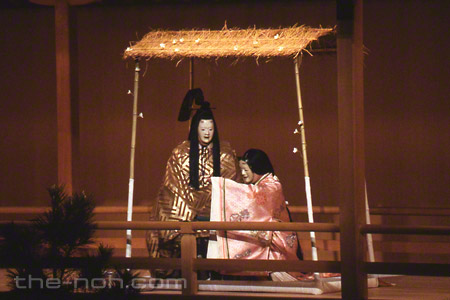 |
From first performance of Yume no Ukihashi in March 3, 2000 at National Noh Theatre 金剛永謹(匂宮)、梅若晋矢(浮橋) ©National Noh Theatre |
The reason is that I myself left home for Tendai Buddhism. Buddhism in this age (the Heian era) was mostly Tendai. That is why the mountain is Mount Hiei and the monks are the monks of the Enryakuji temple. The scene in which she leaves home is the same as 1,000 years ago. That's why I shaved my head I did it in the same way Ukifune did. Only I understand. After leaving home and reading this I was surprised. All of the words given and received by the monks are the same. While I cut my hair with electric clippers, at that time they cut the hair to the shoulders. Because the hair of young women was so full, it was not easy to cut and became uneven. Afterwards the monks ask you to have it made neat, in one word. That was very real for me. Hair cannot be cut straight. I do remember one time in the past when I cut my hair in a fit of nerves (laughingly). It was rough, and not easy to cut, because hair is alive. Those kind of things come out in the story. That is why few Murasaki Shikibu had her head shaved.
That is why I depicted leaving home and chanting Shōmyō
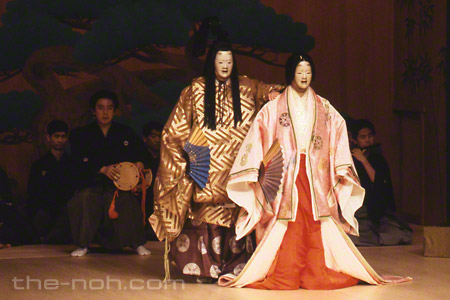 |
梅若晋矢(浮橋)、金剛永謹(匂宮)、一噌隆之(笛)、亀井宏忠(大鼓) ©National Noh Theatre |
When Sōzu Yokawa visited Ukifune, all of the nuns living there were out, and she suddenly asked him to take her in. So it was forced. She didn't have any of the tools. When I left home I prepared a pure white kesa (garment) and many belongings. But not in Ukifune’s case, because she was taken in very suddenly. The Sōzu Yokawa said he would lend his things like clothing and prayer beads. And her hair wasn't directly cut by the Sōzu Yokawa. In my case also, it was cut a little by one of the disciples, and then shaved for real in another room.
During that time, you constantly hear the Shōmyō chant Kigyōbai through the walls. Since they didn't explain this to me I had no idea (laughingly). Maybe for this reason, I could hear men's voices through the wall. During that time my hair was structurally falling off, and I felt extremely relaxed. Kigyōbai is only chanted when the hair is cut. When I had mine cut, Honda, the best Shōmyō chanter at Mount Hiei at the time, chanted for me. Asking later, I learned that it took 40 minutes because my hair was so long. While it usually finishes in one chanting of Kigyōbai, because my hair was so long since it wasn't finished in one chanting it took quite a while two or three chantings (laughingly).
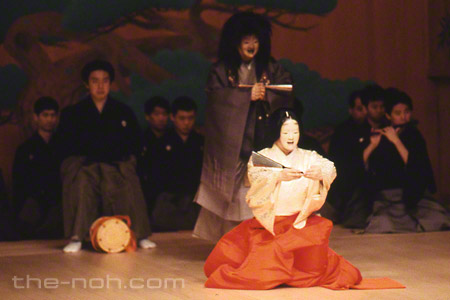 |
梅若晋矢(浮橋)、梅若玄祥(阿闍梨)、一噌隆之(笛)、亀井宏忠(大鼓) 小早川修(地 謡)、小田切康陽(地謡)、清水寛二(地謡) ©National Noh Theatre |
There is one monk who is ordered to cut Ukifune’s hair by the Sōzu of Yokawa in The Tale of Genji. This person is the monk that finds Ukifune at the base of a tree by a home on the opposite shore of the river Ukifune throws herself into when trying to die. That monk and one other carry her inside the home. It is clear that they made love with her there when she could not move. It's not written there, but I imagine. When he carried her unconscious body, he had been living in the mountains since he was young, and had never touched the woman's body before. That's why I think he was shocked. He already knew the feeling of the black hair. Then he cut a woman's hair for the first time. He just was pounding he was so nervous, come handy when crazy -- that's how I interpret it. And after he cut the hair, he placed a little bit in his pocket (laughingly). Rokurō understood everything I had imagined when he played the character. That's why it was so sexual.
Depicting eroticism in Noh
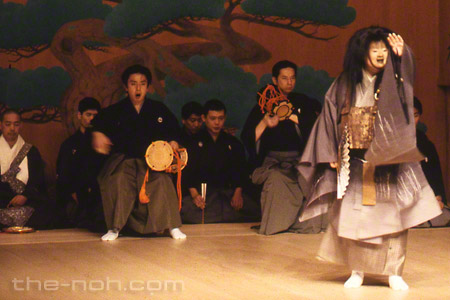 |
梅若玄祥(阿闍梨)、大倉源次郎(小鼓)、亀井宏忠(大鼓)、小早川修(地謡) 小田切康陽(地謡)、清水寛二(地謡)、天納久和(声明) ©National Noh Theatre |
Rokurō depicted the eroticism I had written onstage even further than I had imagined. At the press conference before the first performance he said he would do something surprising, but it would be something that everyone would be surprised at. I wondered what he would do, if he would have them kiss (laughingly). Then their masks met, and it was scary (laughingly). I wonder what he would do – I was so excited. Then, he got “naked.”
He made Ukifune take off the uchikake she was wearing. Under that she had a white kimono with a scarlet hakama. This style of dress is used to represent nudity in Noh. I didn't know that, but he told me it meant she was naked. Then when I looked at her, she was quite sexy, because she was dancing around naked (laughingly). That was what he thought of as the most surprising and erotic scene. When I heard that, Ukifune became more and more erotic, and his hand movements erotic as well. You can imagine that if you're in sensibility and power of understanding. Using your imagination is part of Noh. You gradually build on your own sexiness and appear more erotic (laughingly). But with Noh, it is an elegant and beautiful eroticism.
(Conversation with Jakucho Setouchi)
| Terms of Use | Contact Us | Link to us |
Copyright©
2025
the-NOH.com All right reserved.